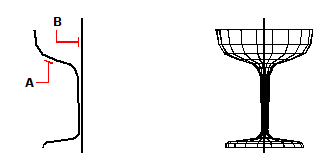Creating revolved meshes
Creating revolved meshes
You can create a revolved mesh, which is a three-dimensional polygon mesh that approximates the surface generated by rotating a two-dimensional profile around an axis. You select the two entities that define the profile and the axis. You also specify the starting angle and the number of degrees to revolve the profile.
Revolving the profile 360 degrees creates a closed three-dimensional mesh.
You can create two types of revolved meshes:
Facet model meshes are smart meshes that can be modified with advanced features such as boolean operations. They are similar to solids but are more lightweight and dont have mass properties.
Surface meshes are simple meshes. Note that the Number Of M-Direction Surfaces value determines the mesh density (the number of mesh segments) in the M-direction (around the axis of revolution). The N-Direction Mesh Density value determines the mesh density (the number of mesh segments) in the N-direction (along the axis of revolution).
To create a revolved facet model mesh -NOT SUPPORTED YET-
1 Do one of the following to choose Revolve ( ):
):
On the ribbon, choose Draw 3D > Revolve (in Facet Model Meshes).
On the menu, choose Draw > Facet Model Meshes > Revolve.
On the Facet Model Meshes toolbar, click the Revolve tool.
Type fmrevolve and then press Enter.
2 Select the entity to revolve.
3 Do one of the following to define the axis of revolution:
Specify a start point and an end point.
Choose Entity and press Enter to select an entity that determines the axis.
Choose Xaxis to select the x-axis.
Choose Yaxis to select the y-axis.
4 Specify the angle of revolution.
To create a revolved surface mesh
1 Do one of the following to choose Revolved Surface ( ):
):
On the ribbon, choose Draw 3D > Revolved Surface (in Draw 3D Meshes).
On the menu, choose Draw > 3D Meshes > Revolved Surface.
On the Draw 3D Meshes toolbar, click the Revolved Surface tool.
Type revsurf and then press Enter.
2 Select the entity to revolve.
3 Select the entity to be used as the axis of revolution.
4 Specify the starting angle.
5 Specify the number of degrees to revolve the entity.
|
|
||
|
Select the entity to be revolved (A) and the axis of revolution (B). |
|
The resulting revolved surface |
The values of the Number of M-Direction Surfaces and N-Direction Mesh Density control the density of the mesh.
Choose Tools > Drawing Settings, click the 3D Settings tab, click the Surfaces tab, then under Surface Settings, change the Number Of M-Direction Surfaces and N-Direction Mesh Density values.
Revolved surfaces can also be created using the Revolve command.
The Revolve command is typically used for creating revolved three-dimensional solids, but it can also be used to create a revolved surface. For more details, see Creating revolved solids or surfaces.

 en
en italiano
italiano čeština
čeština Deutsch
Deutsch français
français hrvatski
hrvatski magyar
magyar polski
polski српски
српски русский
русский 中文
中文 中文
中文 한국어
한국어 español
español